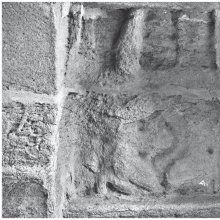E, Ē: 17 definitions
Introduction:
E means something in Hinduism, Sanskrit, the history of ancient India, Marathi, Jainism, Prakrit, Hindi, Tamil. If you want to know the exact meaning, history, etymology or English translation of this term then check out the descriptions on this page. Add your comment or reference to a book if you want to contribute to this summary article.
Images (photo gallery)
(+115 more images available)
In Hinduism
Vyakarana (Sanskrit grammar)
Source: Wikisource: A dictionary of Sanskrit grammarE (ए).—Diphthong vowel ए (e) made up of अ (a) and इ (i), and hence having कण्ठतालु-स्थान (kaṇṭhatālu-sthāna) as its place of origin. It has no short form according to Pāṇini. In cases where a short vowel as a substitute is prescribed for it in grammar, the vowel इ (i) is looked upon as its short form. Patañjali in his Mahābhāṣya has observed that followers of the Sātyamugri and Rāṇāyanīya branches of the Sāmaveda have short ए (e) (ऍ) in their Sāmaveda recital and has given सुजाते अश्वसूनृते, अध्वर्यो अद्रिभिः सुतम् (sujāte aśvasūnṛte, adhvaryo adribhiḥ sutam) as illustrations; cf. M. Bh. on I.1-48; as also the article on.

Vyakarana (व्याकरण, vyākaraṇa) refers to Sanskrit grammar and represents one of the six additional sciences (vedanga) to be studied along with the Vedas. Vyakarana concerns itself with the rules of Sanskrit grammar and linguistic analysis in order to establish the correct context of words and sentences.
Purana and Itihasa (epic history)
Source: archive.org: Puranic EncyclopediaE (ए).—This sound means 'Devī'.

The Purana (पुराण, purāṇas) refers to Sanskrit literature preserving ancient India’s vast cultural history, including historical legends, religious ceremonies, various arts and sciences. The eighteen mahapuranas total over 400,000 shlokas (metrical couplets) and date to at least several centuries BCE.
India history and geography
Source: Cologne Digital Sanskrit Dictionaries: Indian Epigraphical GlossaryĔ.—ḻuttu-viniyogam (SITI), Tamil-Sanskrit; dues payable as ĕḻuttu for the village-accountant to be apportioned among the villagers. Note: ĕ is defined in the “Indian epigraphical glossary” as it can be found on ancient inscriptions commonly written in Sanskrit, Prakrit or Dravidian languages.

The history of India traces the identification of countries, villages, towns and other regions of India, as well as mythology, zoology, royal dynasties, rulers, tribes, local festivities and traditions and regional languages. Ancient India enjoyed religious freedom and encourages the path of Dharma, a concept common to Buddhism, Hinduism, and Jainism.
Languages of India and abroad
Marathi-English dictionary
Source: DDSA: The Molesworth Marathi and English Dictionaryē (ए).—The eighth vowel. It corresponds with E as sounded in most languages of Europe, and as sounded by the Scotch in the English words There, Where. It is of the Sanskrit alphabet the eleventh vowel; but as ṛ, lṛ, lṛ occur not in Maraṭhi, it here succeeds as the eighth.
--- OR ---
ē (ए).—ind (S) A familiar vocative particle; eh! hey!
--- OR ---
ē (ए).—
--- OR ---
ē (ए).—
Source: DDSA: The Aryabhusan school dictionary, Marathi-Englishē (ए).—The 11th vowel. ind A familiar voca- tive particle; oh! bey!
Marathi is an Indo-European language having over 70 million native speakers people in (predominantly) Maharashtra India. Marathi, like many other Indo-Aryan languages, evolved from early forms of Prakrit, which itself is a subset of Sanskrit, one of the most ancient languages of the world.
Sanskrit dictionary
Source: DDSA: The practical Sanskrit-English dictionaryE (ए).—2 P. (ā + i)
1) To come, approach &c.; आमायन्तु ब्रह्मचारिणः (āmāyantu brahmacāriṇaḥ) Tait. Up.1.4.2.
2) To reach, attain, come into (a state or position) स सर्वसमतामेत्य (sa sarvasamatāmetya) Manusmṛti 12.125.
3) To submit; fall to one's share; तस्मात्त्वां पृथग्बलय आयन्ति (tasmāttvāṃ pṛthagbalaya āyanti) Ch. Up.5.14.1. (āyayanti ?) (See i).
--- OR ---
E (ए).—m.
1) Name of Viṣṇu.
2) The number खर्व (kharva). cf. also एः कुमारोऽसुरोऽरातिर्ज्ञातीयोऽहित उद्धतः । आत्मा शेषो विवस्वांश्च कृतार्थो मध्वरिः शरः (eḥ kumāro'suro'rātirjñātīyo'hita uddhataḥ | ātmā śeṣo vivasvāṃśca kṛtārtho madhvariḥ śaraḥ) || Enm. -ind. An interjection of (1) remembering; (2) envy; (3) compassion; (4) calling; (5) contempt or censure.
Derivable forms: eḥ (एः).
Source: Cologne Digital Sanskrit Dictionaries: Shabda-Sagara Sanskrit-English DictionaryE (ए).—The eleventh vowel of the alphabet, corresponding to the letter E as pronounced in most languages except the English, and having the sound of A in amiable.
--- OR ---
E (ए).—ind. An interjection of, 1. Remembering, (ha.) 2. Censure or contempt. 3. Compassion, (ah!) 4. Addressing, (eh! hey.) 5. Calling, (hey, ho.)
--- OR ---
E (ए).—m.
(-eḥ) A name of Vishnu.
Source: Cologne Digital Sanskrit Dictionaries: Cappeller Sanskrit-English DictionaryE (ए).—[pronoun] stem of 3^d person.
--- OR ---
E (ए).—come, go to ([accusative] or [dative]), fall or get into ([accusative]); befall, betide; [with] ūrdhvam rise.
E is a Sanskrit compound consisting of the terms ā and i (इ).
Source: Cologne Digital Sanskrit Dictionaries: Monier-Williams Sanskrit-English Dictionary1) E (ए):—[=ā-√i] [from ā] See e.
2) 1. e the eleventh vowel of the alphabet (corresponding to the letter e as pronounced in prey, grey).
3) 2. e ind. an interjection, [Maitrāyaṇī-saṃhitā]
4) a particle of recollection
5) addressing
6) censure
7) contempt
8) compassion, [cf. Lexicographers, esp. such as amarasiṃha, halāyudha, hemacandra, etc.]
9) 3. e m. Viṣṇu, [cf. Lexicographers, esp. such as amarasiṃha, halāyudha, hemacandra, etc.]
10) 4. e (ā-√i) [Parasmaipada] -eti, to come near or towards, go near, approach, [Ṛg-veda; Atharva-veda; Śatapatha-brāhmaṇa] etc.;
— (with and without punar) to come back, come again to, [Aitareya-brāhmaṇa; Mahābhārata; Kathāsaritsāgara] etc.;
—to reach, attain, enter, come into (a state or position), [Manu-smṛti xii, 125; Meghadūta; Prabodha-candrodaya] etc.;
—to submit, fall to one’s share, [Chāndogya-upaniṣad v, 14, 1] (āyayanti ?), [Kaṭha-upaniṣad] :—[Intensive] [Ātmanepada] (3. [dual number] -iyāte; 1. [plural] -īmahe)
—to hasten near, [Ṛg-veda vii, 39, 2];
—to request, [Vājasaneyi-saṃhitā iv, 5.]
Source: Cologne Digital Sanskrit Dictionaries: Yates Sanskrit-English DictionaryE (ए):—The 11th vowel of the alphabet, like e in there. Interj. ha, ah, hey.
Source: DDSA: Paia-sadda-mahannavo; a comprehensive Prakrit Hindi dictionary (S)E (ए) in the Sanskrit language is related to the Prakrit words: Ai, Ijja, E.
[Sanskrit to German]
Sanskrit, also spelled संस्कृतम् (saṃskṛtam), is an ancient language of India commonly seen as the grandmother of the Indo-European language family (even English!). Closely allied with Prakrit and Pali, Sanskrit is more exhaustive in both grammar and terms and has the most extensive collection of literature in the world, greatly surpassing its sister-languages Greek and Latin.
Hindi dictionary
Source: DDSA: A practical Hindi-English dictionaryE (ए):——the seventh vowel and the seventh letter of the present day Devnagri: alphabet. [If [ṛ] (ri), and also [lṛ] (Iri), are taken into account [e] becomes theninth]; o!, a vocative particle; (just) listen !
...
Prakrit-English dictionary
Source: DDSA: Paia-sadda-mahannavo; a comprehensive Prakrit Hindi dictionaryE (ए) in the Prakrit language is related to the Sanskrit word: E.
Prakrit is an ancient language closely associated with both Pali and Sanskrit. Jain literature is often composed in this language or sub-dialects, such as the Agamas and their commentaries which are written in Ardhamagadhi and Maharashtri Prakrit. The earliest extant texts can be dated to as early as the 4th century BCE although core portions might be older.
Kannada-English dictionary
Source: Alar: Kannada-English corpusE (ಎ):—[noun] the ninth letter and the ninth vowel of the Kannaḍa alphabet.
--- OR ---
Ē (ಏ):—[noun] the tenth letter and the tenth vowel of the Kannaḍa alphabet.
--- OR ---
Ē (ಏ):—
1) [pronoun] used as an interrogative expressing inquiry about the identity, nature or value of an object or matter; what.
2) [pronoun] often used to ask for repetition of an utterance or part of an utterance not properly heard or understood.
3) [pronoun] used as an interrogative expressing inquiry about the character, nature, occupation, position or role of a person; which.
4) [pronoun] either or any, of the persons, things or events previously mentioned or implied.
--- OR ---
Ē (ಏ):—
1) [interjection] an interjection used to express dejection, impatience.
2) [interjection] an interjection used to express surprise, excitement, appreciation, etc.
Kannada is a Dravidian language (as opposed to the Indo-European language family) mainly spoken in the southwestern region of India.
Tamil dictionary
Source: DDSA: University of Madras: Tamil LexiconE (எ) . Seventh letter and vowel of the Tamil alphabet, the half-close front lax unrounded vowel in Tamil; ஏழாமுயிரெழுத்து. [ezhamuyirezhuthu.]
--- OR ---
E (எ) . Symbol for the number 7 in Tamil Arithmetic; ஏழென்னும் எண்ணின் குறி. [ezhennum ennin kuri.]
--- OR ---
E (எ) [Telugu: Kanarese, Malayalam: Travancore usage e.] particle Interrog. base of the interrogative pron.; ஓர் அகவினா. எவன். [or agavina. evan.] — pronominal adjective Interrog. prefix before a noun, meaning what, which; ஒரு புறவினா. எக் கொற்றன் [oru puravina. eg korran] (நன். [nan.] 67, உரை [urai]).
--- OR ---
Ē (ஏ) . Eighth letter and vowel of the Tamil alphabet, the half-close front tense unrounded vowel in Tamil; எட்டாமுயிரெழுத்து. [ettamuyirezhuthu.]
--- OR ---
Ē (ஏ) noun
1. Increase, abundance; பெருக் கம். ஏபெற்றாகும் [perug kam. eperragum] (தொல். சொல். [thol. sol.] 305).
2. Pile, row, tier, series; அடுக்கு. [adukku.] (தொல். சொல். [thol. sol.] 305, உரை. [urai.])
3. Looking upward; மேனோக்குகை. கார்நினைந் தேத்தரு மயிற்குழாம் [menokkugai. karninain thetharu mayirkuzham] (சீவகசிந்தாமணி [sivagasindamani] 87).
4. Pride, self-conceit, arrogance; இறுமாப்பு. ஏக்கழுத்த நாணால் [irumappu. ekkazhutha nanal] (பரிபாடல் [paripadal] 7, 55).
5. Letter of the 4th note of the gamut usually denoted by ம; உழையிசை யின் அக்கரம். (திவா.) [ma; uzhaiyisai yin akkaram. (thiva.)]
--- OR ---
Ē (ஏ) noun cf. ஏவு-. [evu-.]
1. Shooting, as an arrow; எய்யுந்தொழில். ஏமாண்ட நெடும்புரிசை. [eyyunthozhil. emanda nedumburisai.] (புறப்பொருள்வெண்பாமாலை [purapporulvenpamalai] 5, 5).
2. Arrow; அம்பு. ஏமுத லாய வெல்லாப் படைக்கலத் தொழிலு முற்றி [ambu. emutha laya vellap padaikkalath thozhilu murri] (சீவகசிந்தாமணி [sivagasindamani] 370).
--- OR ---
Ē (ஏ) particle
1. Suffix having the force of (a) disjunction, as அவருள் அவனேசொன்னான்; பிரிநிலை யேகாரம் [avarul avanesonnan; pirinilai yegaram]: (b) Interrogative, as நீயே கொண்டாய்; வினா வேகாரம் [niye konday; vina vegaram]: (c) Copulative, as நிலமே நீரே தீயே; எண் ணேகாரம் [nilame nire thiye; en negaram]: (d) Emphasis, as in அதுமெய்யே; தேற்ற வேகாரம் [athumeyye; therra vegaram]: (e) Terminative expletive, as சென்னபட்டணத்திலே; ஈற்ற சை யேகாரம் [sennapattanathile; irra sai yegaram]:
2. A poetic expletive for completing the metre, as ஏயே இவளொருத்தி பேடி; இசைநிறை யேகாரம். [eye ivaloruthi pedi; isainirai yegaram.] (நன். [nan.] 432.)
--- OR ---
Ē (ஏ) interjection cf. hē.
1. An exclamation inviting attention; ஒரு விளிக்குறிப்பு. ஏயெம்பெரு மான் [oru vilikkurippu. eyemberu man] (தேவாரம் [thevaram] 746, 7).
2. An exclamation of contempt; ஒர் இகழ்ச்சிக்குறிப்பு. [or igazhchikkurippu.]
--- OR ---
E (எ) noun (Astrology) Letter representing the cock, in pañca-paṭci; பஞ்சபட்சிகளுள் கோழி யைக் குறிக்கும் எழுத்து. (பிங்கலகண்டு) [panchapadsigalul kozhi yaig kurikkum ezhuthu. (pingalagandu)]
Tamil is an ancient language of India from the Dravidian family spoken by roughly 250 million people mainly in southern India and Sri Lanka.
See also (Relevant definitions)
Starts with (+9711): Abzu, E bao chun, E bonto, E bu shi cao, E chi teng, E do, E jiao mu ye, E kena, E ma huang, E mei dang gui, E mei guan chun hua, E mei jiang hua, E mei qiang wei, E mei qing niu dan, E nibey, E perumay, E ra nda, E ra nda dmar po, E ram nda, E tia.
Ends with (+9980): "aydike", A las doce, A po le, A-ghe kashe, A-mede, A-nede, A-ngakhure, A-tite, Aachadi gadde, Aadasare, Aadathige, Aadde, Aadi mooruthe, Aadishe, Aadsoge, Aadu soge, Aadusoge, Aadusouge, Aaenu jaarige, Aafimise.
Full-text (+65796): Sanjavela, Shubhavela, Eyenal, Phatakila, Jova, Pinnale, Cakattile, Baita, Sutaranala, Sanjha, Madaravana, Jilhai, Ye, Vinca, Sakalata, Ravesa, E-nane, Sakhalata, Suki Kharuja, Suravara.
Relevant text
One of your search terms exceeds the minimun character amount per search term. This amount currently equals 2.
No search results for E, Ē, Ĕ, A-i, Ā-i, Ē°, Ae; (plurals include: is) in any book or story.
Related products
(+151 more products available)











